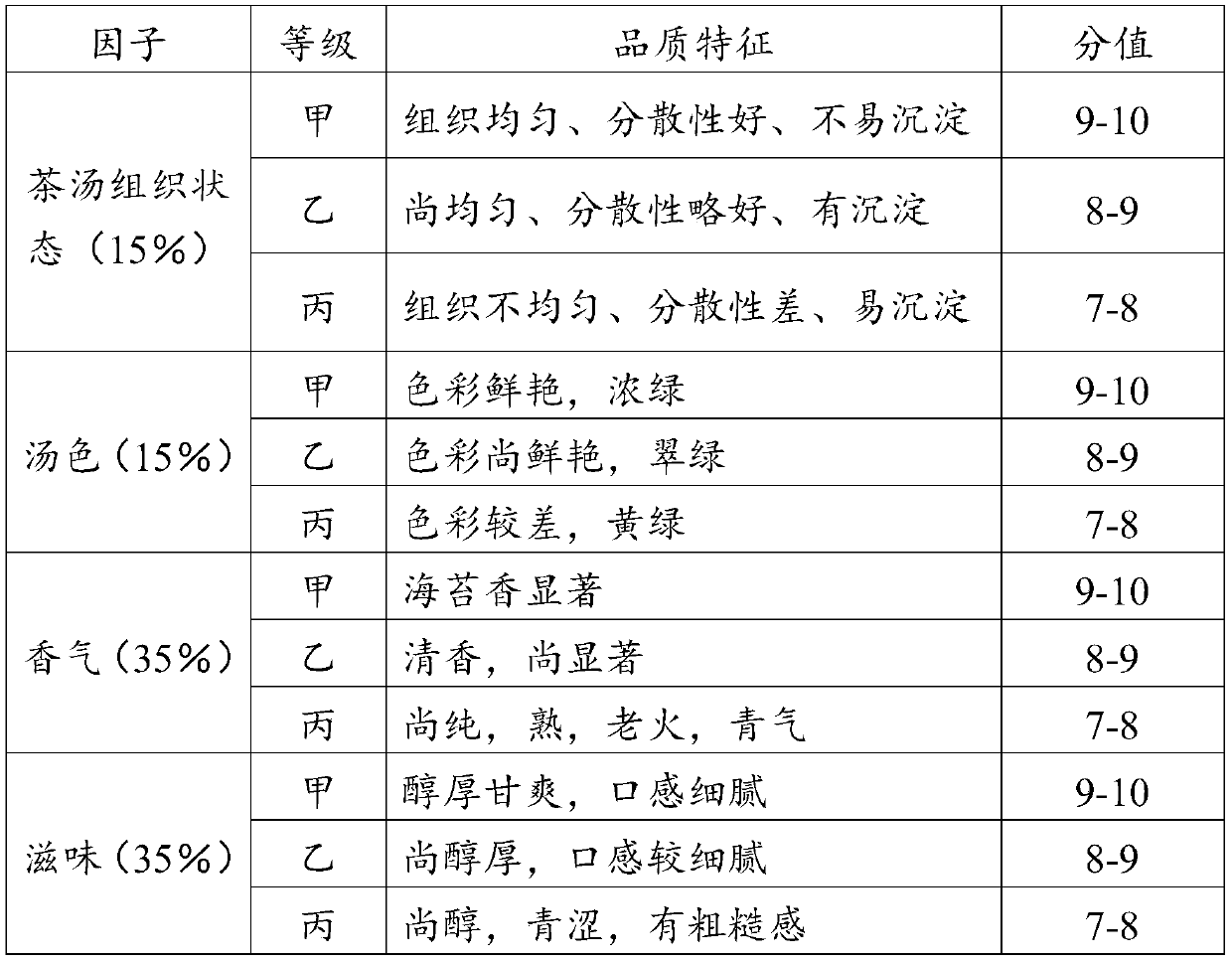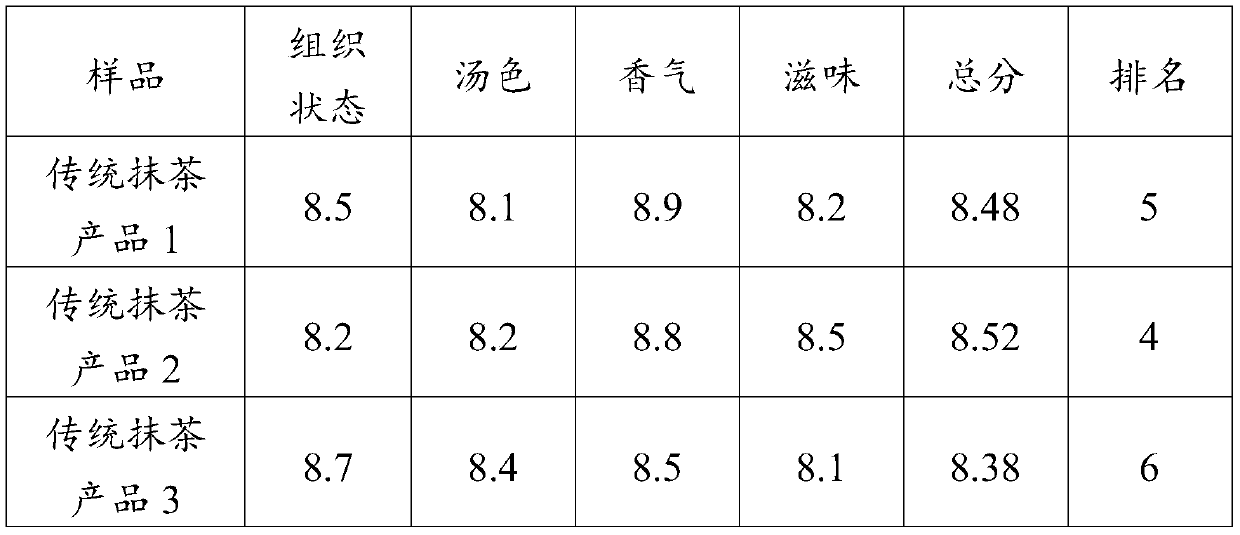Processing method of matcha product
A processing method and product technology, applied in the direction of tea, tea extraction, cosmetics, etc., can solve the problems of large particle size, insufficient fragrance, affecting the dissolution and absorption of products, achieve good solubility and dispersibility, and reduce bitter peptides segment, the effect of retaining aroma and flavor
- Summary
- Abstract
- Description
- Claims
- Application Information
AI Technical Summary
Problems solved by technology
Method used
Image
Examples
Embodiment 1
[0050] The dark green tencha (provided by Shaoxing Yucha Village Tea Co., Ltd.) was selected as raw material from high-quality fresh leaves with high chlorophyll and amino acid content and low tea polyphenol content produced by cover cultivation tea trees in May, and steamed green and dried. Crusher (Wright Electric Co., Ltd., SJ-C152) crushed to 32 purpose ground tea powder.
[0051] Take 1kg of ground tea powder, put it into a beater (Ebest, EB-1803), add 12kg of pure water, and mix evenly to form a mixture for beating. In order to protect the color of the tea leaves during the beating process, 0.5 g cyclodextrin / kg mixture, 0.6 g ascorbic acid / kg mixture and 0.2 g zinc lactate / kg mixture were added. Then, set the beating temperature at 15°C, beat and crush the tencha powder into a beating slag liquid of about 80 mesh.
[0052] After beating is finished, add 1.0g cellulase / kg beating residue liquid, 0.8g pectinase / kg beating residue liquid and 0.6g hemicellulase / kg beating ...
Embodiment 2
[0059] The dark green Tencha (provided by Shaoxing Yucha Village Tea Co., Ltd.) was selected as raw material from high-quality fresh leaves with high chlorophyll and amino acid content and low tea polyphenol content produced by covered cultivation tea trees in April. Crusher (Wright Electric Co., Ltd., SJ-C152) is crushed to 35 mesh milled tea powder.
[0060] Take 1kg of ground tea powder, put it into a beater (Ebest, EB-1803), add 15kg of pure water, and mix evenly to form a mixture for beating. To protect the color of the tea leaves during the beating process, 0.5 g cyclodextrin / kg mix, 0.6 g ascorbic acid / kg mix and 0.5 g zinc lactate / kg mix were added. Then, set the beating temperature at 18°C, beat and crush the tencha powder into a beating slag liquid of about 90 mesh.
[0061] After beating is finished, add 0.8g cellulase / kg beating residue liquid, 0.6g pectinase / kg beating residue liquid and 0.8g hemicellulase / kg beating residue liquid to beating residue liquid, adju...
Embodiment 3
[0066] The dark green tencha (provided by Shaoxing Yucha Village Tea Co., Ltd.) was selected as raw material from high-quality fresh leaves with high chlorophyll and amino acid content and low tea polyphenol content produced by cover cultivation tea trees in May, and steamed green and dried. Crusher (Wright Electric Co., Ltd., SJ-C152) crushed to 28 mesh milled tea powder.
[0067] Take 1kg of ground tea powder, put it into a beater (Ebest, EB-1803), add 14kg of pure water, and mix evenly to form a mixture for beating. In order to protect the color of the tea leaves during the beating process, 0.5 g cyclodextrin / kg mixture, 0.5 g ascorbic acid / kg mixture and 0.8 g zinc lactate / kg mixture were added. Then, set the beating temperature at 17°C, beat and crush the tencha powder into a beating slag liquid of about 100 mesh.
[0068] After beating is finished, add 1.1g cellulase / kg beating residue liquid, 0.7g pectinase / kg beating residue liquid and 0.75g hemicellulase / kg beating r...
PUM
 Login to View More
Login to View More Abstract
Description
Claims
Application Information
 Login to View More
Login to View More - R&D
- Intellectual Property
- Life Sciences
- Materials
- Tech Scout
- Unparalleled Data Quality
- Higher Quality Content
- 60% Fewer Hallucinations
Browse by: Latest US Patents, China's latest patents, Technical Efficacy Thesaurus, Application Domain, Technology Topic, Popular Technical Reports.
© 2025 PatSnap. All rights reserved.Legal|Privacy policy|Modern Slavery Act Transparency Statement|Sitemap|About US| Contact US: help@patsnap.com



